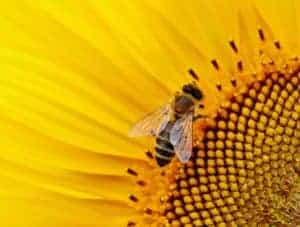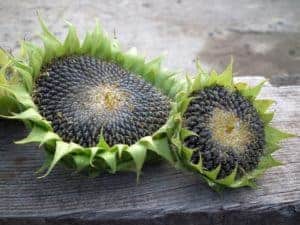If you’re on the fence about whether to grow sunflowers this year, I have to ask: why are you on the fence about something like that?! But seriously, I’ve been guilty of not considering sunflowers in my garden. I do enjoy sunflower seeds but I preferred to dedicate the space in my garden to other vegetables I like. But sunflowers offer more than just sunflower seeds.
There are many benefits of growing sunflowers, but consider how effective they are at attracting pollinators and how nutritious they are as a source of food for you or for birds. If you don’t like the appearance of typical sunflowers, there are many varieties to choose from that come in different colors and sizes, including pollenless cutting sunflowers. Sunflowers are also natural weed suppressants which makes them even easier to grow. And after you’ve harvested the seed heads, you can even cut down and dry out the stalks to use for other things like poles and trellises for beans, peas, cucumbers, etc.
Benefits of Growing Sunflowers
1. Sunflowers are incredible at bringing pollinators to your garden. Flowers look the way they do because they attract pollinating insects like bees. But bees actually see UV light and recent research has shown they even can sense faint electric fields around flowers. Most pollinators will peruse through your garden like aisles in a supermarket, finding flowers as they move along. But sunflowers act as massive, towering beacons that can attract pollinators from all around with their brilliant UV patterns and electrical charges. If you can bring more pollinators into your garden, that means more “customers” going through the “aisles”, pollinating every vegetable, shrub, and fruit tree.

2. Sunflowers are a highly nutritious food crop and can also be a source of birdseed. Don’t underestimate the nutritional value of sunflower seeds. They’re loaded with fiber, healthy plant fats, and loads of vitamins (E, B3, B5, B6, and B9). They are also rich in selenium, copper, and manganese, which are not found in high amounts in most foods. Growing your own sunflower seeds also means you can choose to grow organically and avoid using pesticides, herbicides, or fungicides, meaning your sunflower seeds will not only be healthy but safe for you and your family to eat.
Even if sunflower seeds are not your favorite snack, you can also use them for bird feed. Whether you have your own birds or you want to feed local birds who help eat pests in your garden. And since sunflowers grow so easily, you can basically get bird feed for free. Another note about growing for birdseed is that you don’t need to roast them like sunflower seeds for human consumption – you can even leave them on the sunflower plant for birds to come and peck at them in winter!

3. Sunflowers come in many different varieties, both for food and cutting flowers. So maybe you don’t want to eat sunflower seeds. You can still grow them for cutting flowers. There are even pollenless varieties which won’t produce any pollen (or seed) and still grow beautiful flower heads of different colors (even dark red and purple) for cutting. There are dozens of pollenless sunflowers now but some popular ones are Buttercream, Del Sol, Firecracker, Munchkin, Pro-Cut, and Sunbright.
If you are interested in growing your own sunflower seeds, you can choose from a wide variety of them with different kinds of seeds, sizes of seeds, and flower sizes. A lot of people who want to grow sunflowers like them for their large stalks, but you can also get dwarf varieties that have a more “normal” plant height as well. But if you think bigger is better, Mongolian Giant Sunflowers can get as tall as 15 feet and produce hefty 15-inch flowers!
“… sunflowers act as massive, towering beacons that can attract pollinators from all around with their brilliant UV patterns and electrical charges.”
4. Sunflowers are allelopathic, i.e. natural weed suppressants. Sunflowers naturally release plant growth inhibitors around it in order to prevent different plants from growing and competing with them. This is called allelopathy. This can be a good thing or a bad thing for your garden. The good thing is that you will have less of a weed problem in your sunflower patch. The downside is that it makes companion planting trickier.
Some flowers and vegetables don’t grow well if planted next to sunflowers. Beans, for example, sound like an awesome idea as a companion plant, growing up a sunflower stalk, but beans are actually very sensitive to these plant growth inhibitors. You can definitely try, but give your beans extra space away from the sunflower and then train them up the stalk once they get large enough.
5. You can reuse massive sunflower stalks for other purposes. I’ve just mentioned that planting beans next to sunflowers doesn’t work well. But you can still reuse an old, dried sunflower stalk to make a trellis for beans or other climbing or vining plants. I have to admit this was actually one of the main reasons I started growing a lot more sunflowers – I wanted to grow my own supply of long, 10+ foot bean poles because I didn’t want to buy any.
But there are lots of things you can use old sunflower stalks. You can tie them up and make more complex trellises like teepees and ladder trellises. You can use them for kindling for starting fires. You can even get dozens of them together and tie them in a long line to make a temporary shade roof or fence. If you decide to repurpose your sunflower stalks, bring them into your shed or garage during winter and they will last years.
